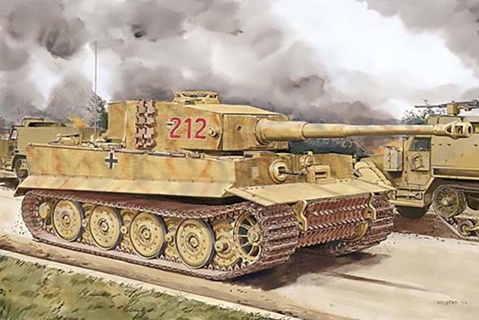1/35 Tiger 1 Late Production
Item No. D6947
Michael Wittmann was one of the most famous tank commanders of World War II, destroying over 150 enemy tanks and 130 other armoured vehicles during his combat career. In the battle in Normandy, Wittmann was associated with two iconic Tiger I tanks that played a pivotal role in his exploits. The firs
Description
Michael Wittmann was one of the most famous tank commanders of World War II, destroying over 150 enemy tanks and 130 other armoured vehicles during his combat career.
In the battle in Normandy, Wittmann was associated with two iconic Tiger I tanks that played a pivotal role in his exploits. The first was Tiger I late production "212", which he employed to devastating effect in the Battle of Villers-Bocage against British and Canadian forces in Normandy. Wittmann's final mount was Tiger I No. 007, the site of his dramatic last stand near the town of St.Aignan de Cramesnil, where his career came to an end on August 8, 1944 when his Tiger was destroyed.
Eighty years after his death, these three famous Tigers remain central to Wittmann's legacy as one of history's greatest tank aces.
In the battle in Normandy, Wittmann was associated with two iconic Tiger I tanks that played a pivotal role in his exploits. The first was Tiger I late production "212", which he employed to devastating effect in the Battle of Villers-Bocage against British and Canadian forces in Normandy. Wittmann's final mount was Tiger I No. 007, the site of his dramatic last stand near the town of St.Aignan de Cramesnil, where his career came to an end on August 8, 1944 when his Tiger was destroyed.
Eighty years after his death, these three famous Tigers remain central to Wittmann's legacy as one of history's greatest tank aces.
1/35 Tiger 1 Late Production
Item No. D6947
Michael Wittmann was one of the most famous tank commanders of World War II, destroying over 150 enemy tanks and 130 other armoured vehicles during his combat career. In the battle in Normandy, Wittmann was associated with two iconic Tiger I tanks that played a pivotal role in his exploits. The firs
Description
Michael Wittmann was one of the most famous tank commanders of World War II, destroying over 150 enemy tanks and 130 other armoured vehicles during his combat career.
In the battle in Normandy, Wittmann was associated with two iconic Tiger I tanks that played a pivotal role in his exploits. The first was Tiger I late production "212", which he employed to devastating effect in the Battle of Villers-Bocage against British and Canadian forces in Normandy. Wittmann's final mount was Tiger I No. 007, the site of his dramatic last stand near the town of St.Aignan de Cramesnil, where his career came to an end on August 8, 1944 when his Tiger was destroyed.
Eighty years after his death, these three famous Tigers remain central to Wittmann's legacy as one of history's greatest tank aces.
In the battle in Normandy, Wittmann was associated with two iconic Tiger I tanks that played a pivotal role in his exploits. The first was Tiger I late production "212", which he employed to devastating effect in the Battle of Villers-Bocage against British and Canadian forces in Normandy. Wittmann's final mount was Tiger I No. 007, the site of his dramatic last stand near the town of St.Aignan de Cramesnil, where his career came to an end on August 8, 1944 when his Tiger was destroyed.
Eighty years after his death, these three famous Tigers remain central to Wittmann's legacy as one of history's greatest tank aces.

